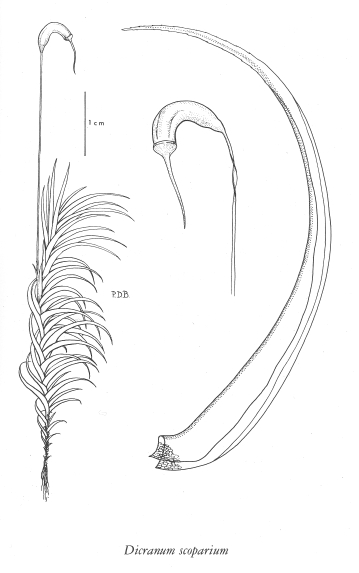Click on the image below to view an
expanded illustration for this species.

|
Species description:
Species name refers to a broom, from the swept appearance of the leaves on the stem.
Reproduction:
Sporophytes common, maturing in spring. In exposed areas the plants often produce brittle shoots that are undoubtedly important to propagation. Comments:
Sometimes called "stork's bill moss" in reference to the strongly snouted operculum, or "broom moss" based on the frequently curved swept-to-one-side appearance of the leaves.
Distinguishing characteristics:
This is an extremely variable species with considerable habitat diversity; therefore, it is readily confused with several other species of Dicranum. The most useful features include the non-undulate, usually curved leaves (except in drier open nutrient-poor sites), the usual lack of abundant matting of rhizoids, and the occurrence of single sporophytes on each shoot.
Habit:
Forming loose to dense, tall turfs of glossy, pale to dark green, generally unbranched or irregularly branched plants that show considerable variability in leaf orientation.
Similar Species:
From D. majus, D. scoparium is readily distinguished on the basis of the multiple sporophytes in the former. When vegetative, these species are difficult to separate, even on microscopic characters. From species of Campylopus and Paraleucobryum the very broad midrib in these two genera will separate D. scoparium with its narrower midrib. In these genera the midrib occupies 1/3, or more of the leaf width.
|
